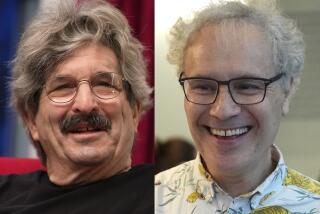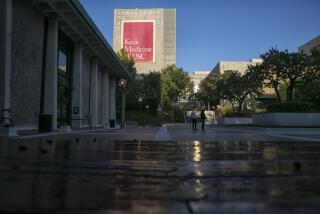Research inspired by swine flu wins $100,000 at Intel science fair
- Share via
A project that could point the way to a new class of drugs to treat influenza won the top prize Tuesday night at the Intel Science Talent Search, netting 17-year-old Eric S. Chen a cool $100,000.
Chen, a senior at Canyon Crest Academy in San Diego, combined chemistry, biology and computer modeling to find compounds capable of blocking an enzyme called endonuclease, which the flu virus needs to spread.
Despite taking home the grand prize at the 2013 Google Science Fair and the top individual honor at the 2013 Siemens Competition in Math, Science and Technology, Chen said he didn’t expect to come in first at the Intel competition.
“I had no idea I was going to win,” Chen told his hometown newspaper, the San Diego Union-Tribune, after the awards were announced in Washington, D.C. “If I had placed between fifth and 10th, I would have been incredibly happy.”
Chen has worked in the lab of Rommie Amaro, an assistant professor of chemistry and biochemistry at UC San Diego, since the summer of 2012. (The lab is down the street from the Salk Institute, established by Chen’s idol, Dr. Jonas Salk.) Gen-Sheng Feng, a molecular biologist at the UCSD School of Medicine, has also advised him on his flu research.
Chen has said his interest in influenza was sparked by the 2009 outbreak of a deadly, never-before-seen virus that came to be known as “swine flu.” The H1N1 strain – a combination of viruses that had come from pigs, birds and humans – killed more than 18,000 people worldwide; the first U.S. cases were in San Diego and Imperial counties.
Winning the Intel science competition may help get Chen’s research noticed by the drug companies he would need to turn his research into real medicine.
“Hopefully we can work together to solve these problems and get these discoveries onto the market,” he told the U-T.
Finding a cure for the flu while finishing high school might sound like enough to keep your hands full. But Chen still finds time to serve as co-president of his high school fencing club (he qualified for the 2013 Junior Olympic Fencing Championships). He also plays piano, tutors Mandarin-speaking senior citizens on basic computer use and runs a math contest for middle schoolers.
Somehow, he has managed to stay humble in the face of so many achievements. The way you’re probably feeling about him is the way he felt about the other 39 Intel finalists he met in Washington.
“A lot of the other students, they blew me away,” he said. “Not only their projects but just how smart they were, how they could think differently than the average person.”
In the 70-plus-year history of the Science Talent Search (founded in 1942 as the Westinghouse Science Talent Search), seven participants have gone on to win Nobel Prizes and 11 won “Genius” grants from the MacArthur Foundation, among other honors.
Chen’s prize money will help pay for college, though he hasn’t yet decided whether to attend Harvard or Stanford, according to the U-T. He says he may pursue a career in academics, or start a company that uses technology to “tackle world problems,” as he put it in his Google Science Fair entry.
Other winners include:
2nd Place: Kevin Lee of Irvine, whose mathematical model of a beating heart could lead to better treatments for arrhythmia.
3rd Place: William Henry Kuszmaul of Lexington, Mass., for a project on the mathematics of modular enumeration that could solve problems in computer science, bioinformatics and computational biology.
4th Place: Joshua Abraham Meier of Teaneck, N.J., for finding a gene that causes stem cells to age rapidly.
5th Place: Natalie Ng of Cupertino, who developed a tool that predicts when breast cancer cells will spread through the body.
6th Place: Aron Coraor of Huntington, N.Y., who studied a mineral on the moon.
7th Place: Zarin Ibnat Rahman of Brookings, S.D., who investigated how screen time affects sleep, stress and learning in teens.
8th Place: Anand Srinivasan of Roswell, Ga., who developed a computer program that makes sense of patterns in DNA data.
9th Place: John Anthony Clarke of Syosset, N.Y., who studied X-ray emissions from Jupiter.
10th Place: Shaun Datta of North Potomac, Md., who made discoveries about the interactions of nuclear matter.
If you’re interested in the latest scientific and medical studies, you like the things I write about. Follow me on Twitter and “like” Los Angeles Times Science & Health on Facebook.







